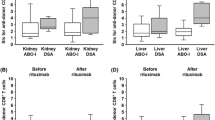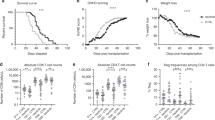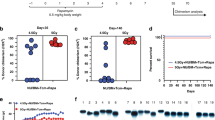Abstract
The scid mutation was backcrossed on to the NOD/Shi mouse background, resulting in the development of NOD/Shi-scid mice, which showed lack of mature lymphocytes, macrophage dysfunction and absence of circulating complement, but were not as impaired in natural killer (NK) cell activity as NOD/LtSz-scid mice. We then examined the effect of recipient NK cell depletion by anti-asialo GM1 antiserum on the repopulation of human cord blood (CB) hematopoietic stem cells (HSC) in NOD/Shi-scid mice to clarify the role of recipient NK cells in human HSC engraftment. The anti-asialo GM1 antiserum treatment significantly enhanced the engraftment of CB CD34+ cells, but did not affect the differentiation of the engrafted HSC into each hematopoietic lineage. The NK cell depletion was effective at early stages of the engraftment, but not 3 weeks after the transplantation. The anti-asialo GM1 antiserum treatment did not improve the engraftment by human HSC in scid mice which lack mature lymphocytes, but show neither macrophage dysfunction nor a reduction in circulating complement, indicating that macrophages and/or complement also have roles in HSC graft rejection. The present study indicates that the preconditioning targeting of recipient NK cells in addition to T cell suppression and myeloablation might prevent HSC graft failure, and that NOD/Shi-scidmice treated with anti-asialo GM1 antiserum could provide a useful tool for evaluating the repopulating ability of transplantable human HSC. Bone Marrow Transplantation (2000) 26, 1211–1216.
This is a preview of subscription content, access via your institution
Access options
Subscribe to this journal
Receive 12 print issues and online access
$259.00 per year
only $21.58 per issue
Buy this article
- Purchase on Springer Link
- Instant access to full article PDF
Prices may be subject to local taxes which are calculated during checkout




Similar content being viewed by others
References
Szilvassay SJ, Humphries RK, Landsorp PM et al. Quantitative assay for totipotent reconstituting hematopoietic stem cells by a competitive repopulation strategy Proc Natl Acad Sci USA 1990 87: 8736–8740
Spangrude GJ, Heimfeld S, Weissman IL . Purification and characterization of mouse hematopoietic stem cells Science 1988 241: 58–62
Omori F, Kruth S, Abrams-Ogg A et al. Extensive in vivo proliferation of genetically modified human hematopoietic stem cells engrafted in pre-immune canine fetuses Blood 1996 88: 270a
Zanjani ED, Pallavicini MG, Ascensao JL et al. Engraftment and long-term expression of human fetal hematopoietic stem cells in sheep following transplantation in utero J Clin Invest 1992 89: 1178–1188
Bosma GC, Cruster RP, Bosma MJ . A severe combined immunodeficiency mutation in the mouse Nature 1983 301: 527–530
Lapidot T, Pflumio F, Doedens M et al. Cytokine stimulation of multilineage hematopoiesis from immature human cells engrafted in SCID mice Science 1992 255: 1137–1141
Shultz L, Schweitzer P, Christianson S et al. Multiple defects in innate and adaptive immunological function in NOD/LtSz-scid mice J Immunol 1995 154: 180–191
Bock T, Orlic D, Dunbar C et al. Improved engraftment of human hematopoietic cells in severe combined immunodeficient (SCID) mice carrying human cytokine transgenes J Exp Med 1995 182: 2037–2043
Pflumio F, Izac B, Katz A et al. Phenotype and function of human hematopoietic cells engrafting immune-deficient CB17-severe combined immunodeficiency mice and nonobese diabetic-severe combined immunodeficiency mice after transplantation of human cord blood mononuclear cells Blood 1996 88: 3731–3740
Greiner DL, Shultz LD, Yates J et al. Improved engraftment of human spleen cells in NOD/LtSz-scid/scid mice as compared with C.B-17-scid/scid mice Am J Pathol 1995 146: 888–902
Larochelle A, Vormoor J, Lapidot T et al. Engraftment of immune-deficient mice with primitive hematopoietic cells from β-thalassemia and sickle cell anemia patients: implications for evaluating human gene therapy protocols Hum Mol Genet 1995 4: 163–172
Larochelle A, Vormoor J, Hanenberg H et al. Identification of primitive human hematopoietic cells capable of repopulating NOD/SCID mouse bone marrow: implications for gene therapy Nature Med 1996 2: 1329–1337
Koyanagi Y, Tanaka Y, Kira J et al. Primary human immunodeficiency virus type 1 viremia and central nervous system invasion in a novel hu-PBL-immunodeficient mouse strain J Virol 1997 71: 2417–2424
Xu M, Tuji K, Ueda T et al. Stimulation of mouse and human primitive hematopoiesis by murine embryonic aorta-gonad-mesonephros-derived stromal cell lines Blood 1998 92: 2032–2040
Ueda T, Tsuji K, Yoshino H et al. Expansion of human NOD/SCID-repopulating cells by stem cell factor, Flt2/Flt3 ligand, thrombopoietin, interleukin-6 and soluble interleukin-6 receptor J Clin Invest 2000 105: 1013–1021
Habu S, Fukui H, Shimamura K et al. In vitro effects of anti-asialo GM1. I. Reduction of NK activity and enhancement of transplanted tumor growth in nude mice J Immunol 1981 127: 34–38
Yu YY, Kumar V, Bennett M . Murine natural killer cells and marrow graft rejection Annu Rev Immunol 1992 10: 189–213
Sharabi Y, Aksentijevich I, Sundt TM III et al. Specific tolerance induction across a xenogeneic barrier: production of mixed rat/mouse lymphohematopoietic chimeras using a nonlethal preparative regimen J Exp Med 1990 172: 195–202
Aizawa S, Sado H, Kamisaka H et al. Cellular basis of the immunohematologic defects observed in short-term semiallogeneic B6C3F1 → C3H chimeras: evidence for host-versus-graft reaction initiated by radioresistant T cells Cell Immunol 1980 56: 47–57
von Melchner H, Bartlett PF . Mechanisms of early allogeneic marrow graft rejection Immunol Rev 1983 71: 31–56
Dennert G, Anderson CG, Warner J . T killer cells play a role in allogeneic marrow graft rejection but not in hybrid resistance J Immunol 1985 135: 3729–3734
Wagner JE, Kernan NA, Steinbuch M et al. Allogeneic sibling umbilical cord blood transplantation in forty-four children with malignant and non-malignant disease Lancet 1995 346: 214–219
Acknowledgements
This study was supported by the Program for Promotion of Fundamental Studies in Health Science of the Organization for Pharmaceutical Safety and Research of Japan.
Author information
Authors and Affiliations
Rights and permissions
About this article
Cite this article
Yoshino, H., Ueda, T., Kawahata, M. et al. Natural killer cell depletion by anti-asialo GM1 antiserum treatment enhances human hematopoietic stem cell engraftment in NOD/Shi-scid mice. Bone Marrow Transplant 26, 1211–1216 (2000). https://doi.org/10.1038/sj.bmt.1702702
Received:
Accepted:
Published:
Issue Date:
DOI: https://doi.org/10.1038/sj.bmt.1702702
Keywords
This article is cited by
-
Dual roles of neutrophils in metastatic colonization are governed by the host NK cell status
Nature Communications (2020)
-
Engineering a humanized bone organ model in mice to study bone metastases
Nature Protocols (2017)
-
Natural killer (NK) cells inhibit systemic metastasis of glioblastoma cells and have therapeutic effects against glioblastomas in the brain
BMC Cancer (2015)
-
NK cells impede glioblastoma virotherapy through NKp30 and NKp46 natural cytotoxicity receptors
Nature Medicine (2012)
-
HIV-1 immunopathogenesis in humanized mouse models
Cellular & Molecular Immunology (2012)



